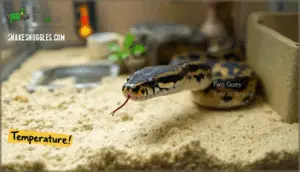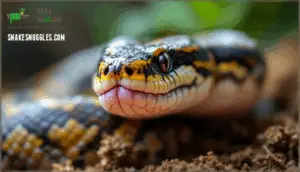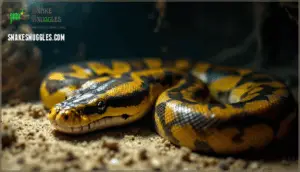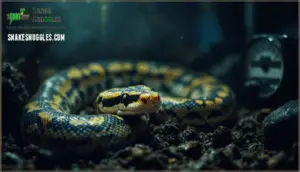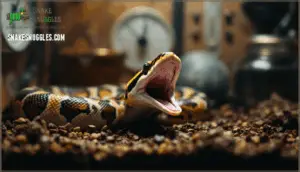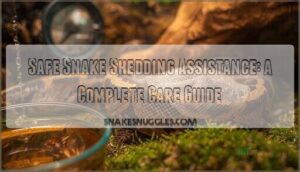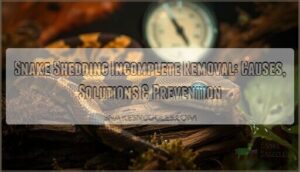This site is supported by our readers. We may earn a commission, at no cost to you, if you purchase through links.

Understanding the difference between normal respiratory adjustments and true respiratory distress can mean the difference between a simple husbandry tweak and a veterinary emergency. Temperature imbalances, humidity problems, and early infections commonly trigger these deep breathing episodes, but recognizing the warning signs early gives you the power to act before minor issues become serious health threats.
Table Of Contents
- Key Takeaways
- Normal Breathing Patterns in Ball Pythons
- Causes of Deep Breaths in Ball Pythons
- Recognizing Abnormal Breathing and Warning Signs
- Respiratory Infections: Symptoms and Solutions
- Preventing Respiratory Issues in Ball Pythons
- Frequently Asked Questions (FAQs)
- Why do ball pythons breathe deeply?
- Can ball pythons get respiratory infection?
- What should I do if my ball python is sick?
- Why does a ball python make a wheezing noise?
- How do you treat a baby ball python respiratory infection?
- How to care for a ball python?
- Why is my ball python taking deep breaths?
- What are the signs of respiratory distress in a ball python?
- What does a respiratory infection sound like in a ball python?
- Should I be able to hear my ball python breathe?
- Conclusion
Key Takeaways
- Deep breathing in ball pythons usually signals environmental problems like incorrect temperature (should be 90-95°F basking, 75-80°F cool side) or humidity issues (maintain 50-60%), rather than immediate illness.
- Respiratory infections show distinct warning signs beyond deep breaths—watch for open-mouth breathing, audible wheezing or clicking sounds, mucus discharge from nostrils, and persistent lethargy lasting beyond 24 hours.
- Normal post-feeding breathing increases are temporary and expected, with oxygen consumption spiking up to five times baseline within 48 hours of eating, but stress-related breathing should resolve within 15-30 minutes.
- Early veterinary intervention is critical when respiratory symptoms appear, as infections progress quickly and require specific antibiotic treatment combined with optimized enclosure conditions (increased temperature to 88-92°F and 60-80% humidity) for recovery.
Normal Breathing Patterns in Ball Pythons
Before you worry about your ball python’s breathing, it’s important to know what’s actually normal. A healthy snake’s respiration changes based on what it’s doing, where it’s sitting in the enclosure, and whether it’s recently eaten. Understanding these baseline patterns helps you recognize when something’s truly off.
Typical Respiration Rate and Physiology
Your ball python’s respiratory system centers on a single functional right lung with an impressive oxygen uptake capacity of about 61 ml per minute per kilogram. At rest, healthy adults breathe just 1–2 times per minute—slow and silent. This reflects their low metabolic needs and efficient lung anatomy.
Ball pythons breathe just once or twice per minute at rest, relying on a single efficient lung that silently powers their remarkably low metabolism
Because snakes lack a diaphragm, they rely entirely on rib muscles for ventilation. Temperature directly affects their metabolic rate and breathing, so proper enclosure conditions help maintain normal oxygen levels and prevent respiratory disease.
Snakes use a glottis to breathe, which can extend while eating.
Changes After Eating or Activity
After digesting prey, your ball python’s oxygen consumption can spike up to five times its baseline within 48 hours—visible as deeper, more frequent breaths. This post-meal respiration is normal and reflects intense metabolic work.
Stress from handling or enclosure changes also triggers rapid breathing temporarily, but it should settle once your snake feels secure again in its enclosure environment for snakes.
This increase is related to the python’s digestive physiology and the energetic costs associated with it.
Effects of Temperature and Humidity
Your snake’s respiratory effort shifts with enclosure temperature and humidity—two variables that directly affect how it breathes. Maintaining ideal temperature and humidity balance prevents unnecessary strain on your ball python’s respiratory system. Here’s how enclosure conditions influence breathing:
- Basking surface temperature of 90–95°F promotes healthy metabolic and respiratory function.
- Ambient enclosure temperature around 82°F ensures proper thermoregulation without respiratory fatigue.
- Humidity between 55–70% keeps airway mucus at the right viscosity, preventing infection.
- Low humidity below 50% dries mucous membranes, forcing deeper, more labored breaths.
- Temperature swings greater than 5°F trigger stress-related deep breathing episodes.
Preventive management means monitoring both enclosure temperature and enclosure humidity with calibrated probes, ensuring your ball python breathes comfortably without compensating for environmental imbalances.
Causes of Deep Breaths in Ball Pythons
When your ball python takes deep breaths, it’s usually telling you something about its environment or health. The two main culprits are problems with your setup or the early stages of illness.
Let’s look at what might be causing this behavior.
Environmental Factors and Husbandry
Your enclosure setup can make or break your ball python’s respiratory comfort. Temperature gradients should span from 75–80°F on the cool side to 88–92°F on the basking side—anything outside this range can trigger deep breathing as your snake struggles with inefficient oxygen uptake.
Humidity balance between 60–80% is equally critical; too dry irritates airways, while excess moisture above 85% invites bacterial growth.
Substrate influence matters too—coconut fiber or cypress mulch maintains stable humidity without promoting mold. Proper enclosure size, lighting effects that support natural cycles, and adequate ventilation all reduce stress-related breathing changes.
Early Signs of Illness
Unfortunately, illness often announces itself subtly before dramatic symptoms appear. Lethargy signs—like extended hiding or reduced movement—frequently emerge alongside appetite changes, where your snake refuses several consecutive meals.
Breathing issues such as wheezing or audible respiratory noises warrant immediate attention, especially when paired with mucus discharge around the nostrils or mouth.
Open-mouth breathing and early neuro symptoms like minor head wobbling demand swift action, because early intervention greatly improves treatment outcomes and prevents severe respiratory infection development.
Recognizing Abnormal Breathing and Warning Signs
Not all deep breaths mean trouble, but some signs demand your attention right away. Knowing the difference between normal breathing and a real problem can save your snake‘s life.
Here’s what to watch for when something’s off.
Open-Mouth Breathing and Audible Noises
When your ball python breathes with its mouth open, it’s signaling real trouble. This isn’t normal behavior—it’s one of the clearest infection indicators you’ll see. Watch for these respiratory noises and signs of respiratory tract infection:
- Audible exhalation with clicking or wheezing signs during breathing
- Gurgling sounds suggesting fluid trapped in the airway
- Mouth gaping lasting longer than 60 seconds
- Heavy breathing in ball pythons combined with visible weakness
Open-mouth breathing isn’t part of healthy respiration—it reveals your snake is struggling to get enough oxygen, pointing to serious ball python health issues needing immediate veterinary attention.
Mucus, Discharge, and Lethargy
Beyond visible breathing efforts, you should check for mucus buildup and nasal discharge patterns—both key respiratory infection symptoms. Nidovirus infections produce mucus in up to 70% of cases, often appearing as bubbles at the nostrils or oral crusting.
Lethargy follows quickly, with over 65% of affected snakes showing reduced movement within days. These systemic effects signal clinical progression requiring immediate veterinary care, as husbandry contributions like low humidity worsen respiratory tract infection severity.
Differentiating Stress From Respiratory Distress
Stress tachypnea resolves within 15–30 minutes, while respiratory distress persists beyond 24 hours with clinical markers like open-mouth breathing or audible clicks. If your snake’s breathing heavily after handling, observe for normalization—stressed pythons resume tongue-flicking within 20 minutes, but infection shows sustained symptoms regardless of environmental assessment.
Diagnostic imaging confirms pulmonary thickening in 93% of respiratory infections, making observation protocols essential for differentiating temporary stress from true snake health emergencies.
Respiratory Infections: Symptoms and Solutions
Respiratory infections don’t appear overnight—they build up when your ball python’s immune system can’t keep up with bacteria or environmental stressors. Understanding what puts your snake at risk, how your vet will diagnose the problem, and what treatment looks like can help you act quickly when something’s wrong.
Here’s what you need to know about managing respiratory infections from start to finish.
Common Causes and Risk Factors
Your ball python’s respiratory system faces several threats, and knowing them helps you protect your snake. Inadequate temperature ranges below 75°F or above 92°F weaken immunity and strain breathing, while inappropriate humidity under 40% or over 80% creates conditions for infection.
Poor hygiene, including infrequent cleaning, allows bacterial pathogens like Aeromonas to flourish. Viral pathogens, particularly ball python nidovirus affecting over 70% of respiratory cases, spread easily between snakes.
Stress from overcrowding or excessive handling suppresses your snake’s defenses by up to 40%, making proper ball python care and snake husbandry essential.
Diagnosis and Veterinary Care
When your ball python shows worrying respiratory symptoms, veterinary care becomes critical. Your veterinarian follows a structured approach to pinpoint the problem and start appropriate treatment:
- Physical examination checks for open-mouth breathing, nasal discharge, and oral redness during clinical assessment
- Diagnostic imaging through radiographs reveals pneumonia or fluid accumulation in lung tissue
- Laboratory testing using PCR assays identifies bacterial pathogens or serpentovirus infections
- Microbial cultures from tracheal lavages guide targeted antibiotic therapy selection
Veterinary diagnosis combines these tools for accurate case management and veterinary medicine intervention.
Treatment and Home Support
Once diagnosis confirms infection, treatment combines veterinary care with home support. Your veterinarian will prescribe antibiotics like ceftazidime (20–40 mg/kg every 2–3 days) or enrofloxacin (5–10 mg/kg daily) to fight bacterial pathogens. Simultaneously, you should improve enclosure conditions by raising the temperature to 80–92°F and maintaining humidity between 60–80% to support healing.
| Treatment Component | Action Steps |
|---|---|
| Antibiotic options | Administer prescribed medications exactly as directed |
| Temperature adjustment | Increase basking spot to 88–92°F for immune support |
| Hydration methods | Mist enclosure and provide fresh water daily |
| Steam therapy | Use 10–20 minute sealed-tub sessions for mucus relief |
| Isolation protocols | Separate sick snakes and follow disinfection routines |
Monitor your python for 14 days, escalating to veterinary care if symptoms persist beyond 48 hours.
Preventing Respiratory Issues in Ball Pythons
Preventing respiratory problems in your ball python starts with three essential areas of care. Good husbandry practices create a foundation that keeps your snake healthy and reduces the risk of illness.
Let’s look at the specific steps you can take to protect your ball python’s respiratory health.
Optimizing Enclosure Conditions
Your enclosure’s temperature, humidity, and airflow work together to prevent respiratory problems. Maintain a temperature gradient of 90–95°F on the warm side and 78–80°F on the cool side, keeping humidity between 50–60% with proper ventilation through mesh tops or side vents.
Use at least 4 inches of moisture-retaining substrate like coconut fiber, perform weekly spot cleaning, and consider automated monitoring systems with thermostats to maintain stable conditions within ±2°F and ±5% humidity.
Reducing Stress and Proper Handling
While a well-maintained enclosure lays the groundwork, how you interact with your ball python directly affects its stress levels and respiratory health. Allow 7–14 days after bringing your snake home before you start handling it—this acclimation period lets stress hormones settle and immune function stabilize.
Once settled, handle your python 1–3 times weekly for no more than 10–15 minutes, using slow, predictable movements that support its entire body. Avoid handling for 48–72 hours after feeding to prevent regurgitation-related stress.
Routine Health Monitoring and Quarantine Practices
Beyond handling, preventative measures like regular monitoring keep respiratory issues at bay. Schedule veterinary care every 6–12 months to catch early signs of disease before symptoms appear. When adding new snakes, quarantine them for 30–90 days in a separate space to prevent introducing infections.
- Disinfection practices: Clean enclosures every 7–10 days with quaternary ammonium compounds and use dedicated tools for quarantine areas
- Stress reduction: Maintain 50–60% humidity and stable temperatures to support immune health during the adjustment period
- Recordkeeping logs: Track feeding, shedding, and breathing patterns to spot deviations that signal reptile health concerns
Frequently Asked Questions (FAQs)
Why do ball pythons breathe deeply?
Deep breathing in ball pythons isn’t always cause for alarm—sometimes it’s just your snake adjusting to temperature effects or digesting a meal.
However, stress response, husbandry impact issues, or early symptoms of respiratory illness can trigger noticeable huffing or labored breaths.
Can ball pythons get respiratory infection?
Yes, ball pythons can get respiratory infections. Common pathogens include bacteria, Mycoplasma, nidoviruses, and fungi.
Symptoms of respiratory problems include wheezing, mucus discharge, and lethargy. Early detection improves treatment options greatly.
Veterinary care for snakes and proper prevention strategies reduce infection risk factors in reptile respiratory infections.
What should I do if my ball python is sick?
Contact your veterinarian immediately if your ball python shows snake illness symptoms like abnormal breathing, lethargy, or discharge.
Early veterinary care and symptom monitoring are critical for effective snake treatment and preventing serious snake health issues.
Why does a ball python make a wheezing noise?
Wheezing noises often signal respiratory infections—bacteria, viruses, or fungi attacking your snake’s lungs.
These sounds (rattling, clicking, whistling) indicate mucus buildup or airway obstruction, requiring immediate veterinary attention since ball pythons can’t cough effectively to clear debris.
How do you treat a baby ball python respiratory infection?
Treating a baby ball python respiratory infection requires veterinary expertise and early intervention for snake illness. Your vet will prescribe antibiotics like enrofloxacin to target the bacterial infection or pneumonia.
At home, you’ll support recovery through hydration therapy, ideal enclosure temperatures, and possibly nebulization benefits to ease breathing. Some vets recommend probiotic use alongside treatment.
Prompt veterinary advice for reptiles makes all the difference in your snake’s outcome.
How to care for a ball python?
Keeping a ball python healthy isn’t rocket science, but it does require consistency. Focus on enclosure essentials like proper temperature gradients (90-95°F basking, 75-80°F cool side), humidity at 50-60%, and adequate ventilation.
Establish regular feeding habits, gentle handling techniques, and monitor the shedding process. Watch for common ailments and contact your veterinarian if concerns arise—good husbandry prevents most problems.
Why is my ball python taking deep breaths?
Your ball python’s deep breaths can stem from stress, environmental imbalances, or early respiratory distress. Stress indicators like recent handling, inadequate humidity levels, or poor enclosure ventilation often trigger this behavior.
Dehydration symptoms and shedding effects also increase respiratory effort, while respiratory infection symptoms—including open-mouth breathing and respiratory noises—signal potential respiratory distress requiring immediate attention.
What are the signs of respiratory distress in a ball python?
If your snake struggles to breathe, you’ll notice open-mouth breathing, audible wheezing or clicking, nasal discharge, mucus around the nostrils, increased breathing effort, and lethargy signs—all indicating respiratory distress requiring immediate veterinary attention.
What does a respiratory infection sound like in a ball python?
A respiratory infection commonly produces wheezing, clicking, gurgling, or raspy breathing sounds when your ball python inhales or exhales. You might also hear crackling noises or heavy breathing, sometimes accompanied by mucus bubbles at the nostrils or open-mouth breathing—all signs requiring prompt veterinary attention.
Should I be able to hear my ball python breathe?
Under normal conditions, you shouldn’t hear your ball python breathe. Healthy snakes breathe quietly, with no audible breathing or respiratory noises.
If you’re hearing wheezing, clicking, or breathing heavily, these concerning noises signal respiratory disease. Clinical signs like this mean it’s time to worry—audible sounds usually point to infection or environmental impact on respiratory health.
Conclusion
Like a canary in a coal mine, your ball python taking deep breaths acts as an early warning system you shouldn’t ignore. When you spot these exaggerated breathing movements, check your enclosure’s temperature and humidity first—most cases stem from simple husbandry adjustments rather than serious illness.
However, if deep breaths come with mucus, lethargy, or audible wheezing, contact your exotic veterinarian immediately, because respiratory infections progress quickly without proper treatment and can threaten your snake’s life.
- https://www.petmd.com/reptile/conditions/respiratory/respiratory-infections-reptiles
- https://journals.biologists.com/jeb/article/218/13/2089/13810/Digesting-pythons-quickly-oxidize-the-proteins-in
- https://reptifiles.com/ball-python-care-guide/ball-python-humidity-temperatures/
- https://community.morphmarket.com/t/how-to-tell-if-my-bp-is-stressed/4954
- https://www.youtube.com/watch?v=QUOYffq7LCs

